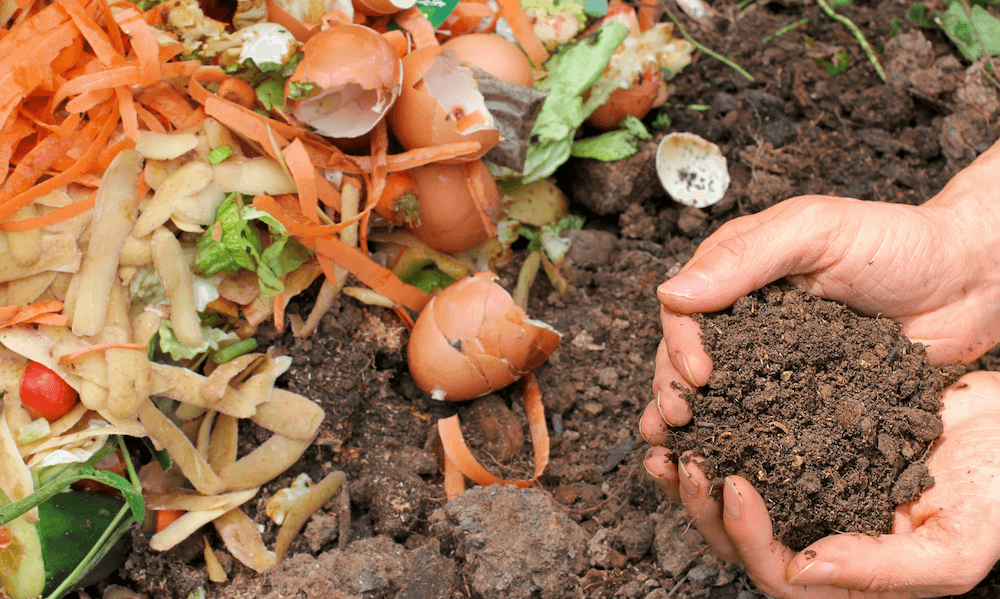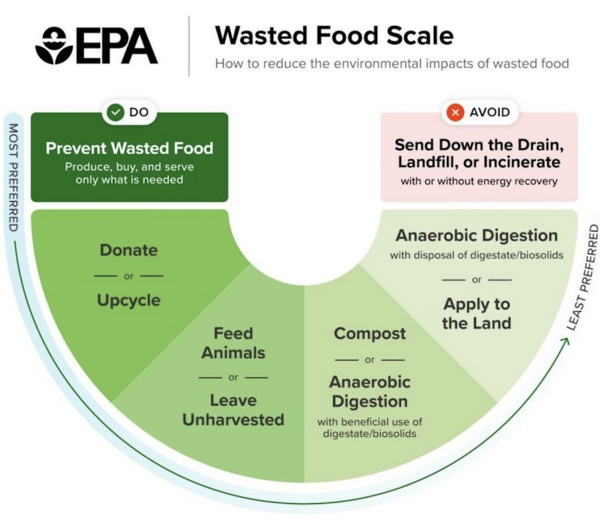Food
This page includes information to enhance literacy about the impacts of food production and waste, demonstrate what Notre Dame is doing to address its food impacts, and how you can be inspired to take action.

Every human is deeply connected with food. It's a representation of culture, art, geography, and history. And in the realm of sustainability, managing the impacts of food is incredibly complex. It is intimately tied to sustainability work, and the consequences are vast. From production to consumption, factors like agricultural practices, water requirements, transportation, preparation, and eating habits all determine the ecological, climate, and social effects of our food.
What is Food Waste?
The term “wasted food” describes food that was not used for its intended purpose and is managed in a variety of ways, as described by the EPA.
Impacts of Food Production & Waste
Nearly 40% of all food waste occurs at the consumer level, and the EPA estimates that more food reaches landfills than any other single material in our everyday trash, constituting 24% of municipal solid waste. Moreover, 8% of greenhouse gases (GHGs) are caused by food waste, 6% of all GHGs are emitted from transporting food, and rotting food in landfills contributes up to 34% percent of all human-related methane (CH4) emissions across the globe. Overall, food waste contributes 3.3 million gigatons of carbon dioxide (CO2) into the atmosphere. This is double the emissions of all U.S. road transportation in 2010.1, 2
Agriculture’s blue water (fresh water from irrigation or aquifer sources) usage is also putting a strain on potable water resources. The Food and Agriculture Organization of the United Nations estimated that the blue water footprint of wasted food from 2007 was about 250 cubic kilometers. This amount of water is more than 38 times the blue water usage of all U.S. households, and 3.6 times the total footprint of U.S. consumption. Food production’s usage of blue water not only threatens water depletion and scarcity, but also contributes to salinization, waterlogging, and soil degradation. When food is wasted, these precious resources used to produce such goods are also wasted.2, 3
How Notre Dame is Addressing Impacts of Food & Food Waste
Sustainability-Minded Sourcing
Because many of the environmental and social effects of food occur in production and transportation, Notre Dame is committed to carefully procuring food and beverages from local and minority-owned businesses whenever possible. Additionally, other considerations for sources include sustainable agricultural practices and certifications like B-Corp, Fair Trade, and Rain Forest Alliance.
Grind2Energy
Pre and post-consumer food waste is diverted from the landfill by utilizing the Grind2Energy technology provided by Insinkerator Emerson. The technology processes food and then pipes it to an onsite tank where it is then pumped by a local septic hauler and brought to an area dairy farm that has existing anaerobic digestion and a closed-loop approach to using the food waste donation.
Cultivate Culinary
The University maintains an ongoing partnership with Cultivate Culinary to provide high-quality, well-balanced meals to food-insecure families throughout the Michiana area. Food is rescued from events as well as normal dining operations. Cultivate "rescues" and reuses food through multiple programs, including a weekend backpack program to feed K-12 students facing poverty. Much of this food comes from Campus Dining as well as Athletic events. During the COVID-19 campus shutdown, Cultivate also received all of the fresh produce that would have otherwise gone to waste.
In the 2021-22 academic year, Notre Dame donated almost 34 tons of food to Cultivate. Read more about Cultivate's impact.
LeanPath
The Dining Halls and select dining locations on campus began utilizing LeanPath in November 2015 to prevent and calculate food waste. By taking photographs of leftover food, categorizing the waste, and weighing the food, staff have been able to better understand the campus' food consumption habits and adjust meal preparations accordingly.
From January 2016 through June 2016, Campus Dining prevented 76,627 pounds of food from being landfilled—the equivalent weight of over seven elephants! This process also reduced CO2 emissions by an amount equal to using 3,247 gallons of gasoline.
RTI Oil Management
Campus Dining uses an oil management system that allows the dining halls to supply fresh, clean oil to kitchens and dispose of used oil with the click of a button. The contactless system allows for easier, safer disposal, and eliminates packaging. Best of all, 90 percent of the used oil is then taken to RTI’s facilities where it is recycled and turned into biodiesel. Biodiesel is a renewable energy source that can reduce carbon dioxide emissions by up to 75 percent compared to regular diesel, as well as reducing carbon monoxide and soot particles. The 10 percent of oil that cannot be turned into biodiesel gets turned into animal feed, ensuring nothing is wasted.
How You Can Affect Change and Reduce Impacts Associated with Food & Food Waste
While the topic of food impacts and food waste can feel overwhelming, it's important to remember that you have the power to make a difference! Preventing food waste helps increase food security, reduce GHG emissions, protect precious natural resources, and save money.

Follow the Dining Hall’s Recommendations on How to Dispose of Food Waste
Our Grind2Energy program converts dining hall food waste into usable energy, animal feed, and animal bedding for a local farm. By choosing to follow the signs posted in North Dining Hall and South Dining Hall, you are helping divert food waste and support a local farm. Remember to eat all you would like but take only what you can finish to prevent excess waste.
Buy and Take Only What is Needed
When grocery shopping, plan out your meals and opt to buy only enough food that you think you will eat. When purchasing too much perishable food, the food you do not eat is at risk of becoming wasted. If you are hosting a party, be sure to plan ahead and purchase enough food to keep everyone full, but not so much that you're throwing food away and begging your guests to take leftovers. Utilize planning tools like Save the Food's guestimator to estimate how much food you will need based on eating habits and headcount to satiate your guests' hunger.
Try a Flexitarian Diet
Adopting a more flexitarian diet can help reduce the impact of what you eat. Here are a few reasons why:
- Lower Carbon Footprint: Plant-based foods generally have a lower carbon footprint than animal-based foods. Producing vegetables, fruits, grains, and legumes typically involves fewer greenhouse gas emissions compared to raising livestock.
- Reduced Deforestation: A substantial amount of deforestation occurs to make way for livestock farming, especially in regions like the Amazon rainforest. By consuming less meat, we can help reduce the demand for this land conversion, which contributes to both deforestation and carbon emissions.
- Less Water Usage: The meat industry requires significant amounts of water for animal husbandry and feed production. A shift towards a more plant-based diet can help conserve water resources.
- Reduced Methane Emissions: Livestock, especially cattle, produce CH4, which can retain 80% more heat than CO2, making it a major contributor to climate change.
- Preserving Biodiversity: Large-scale livestock farming often leads to habitat destruction and a loss of biodiversity. Choosing plant-based options can help preserve natural ecosystems and the species within them. However, the same can be said for many farm practices, such as monoculture and excessive use of synthetic fertilizers, pesticides, and herbicides. Therefore, supporting producers and organizations that reject such practices can be just as important
- Health Benefits: A more flexitarian diet that includes a variety of plant-based foods can also offer health benefits, such as reducing the high levels of LDL cholesterol, which may lead to cardiovascular disease.
While adopting a fully plant-based diet may not be feasible or desirable for everyone, even small changes in one's diet, such as participating in meatless Mondays or substituting some meat meals with plant-based alternatives, can contribute to a reduction in greenhouse gas emissions and promote a more sustainable food system. It's an effective way for individuals to make a positive impact and contribute to the fight against climate change. Additionally, supporting sustainable and environmentally conscious agricultural practices can further enhance the effectiveness of these efforts.
Composting & Vermiculture
If you live off campus and have access to a small area of land outside, you can try out at-home composting! If your outdoor space is limited, vermiculture, also known as worm composting, is an excellent way to save space and mitigate food scraps from entering the landfill. Both options divert waste from the landfill and provide you with nutrient-rich soil amendments that are great for houseplants, garden beds, and flower boxes. If you build up more compost or worm castings than you can use, simply adding these to soil improves soil health, reduces the potential for erosion, sequesters carbon, and reduces the need for pesticides and fertilizers.
Sustainability & Food Across the University
Learn more about our key partners and the academic work that supports advancing sustainability & food at Notre Dame:
- Eight tons of surplus food saved, repurposed from Notre Dame Stadium during 2022 football season
- Cheryl Bauer, Director of Supply Chain & Sustainability
- Karim Tinoco, Sustainable Food & Kitchen Program Manager
- Campus Dining Sustainability
- Keough School plays key role in COP28 climate talks on food systems
- The Pulte Institute researches digital agriculture in Ecuador
Sources:
3: Aldaya, M.M., Allan, J.A., & Hoekstra, A.Y.; Strategic Importance of Green Water in International Crop Trade. Ecological Economics, 2010.